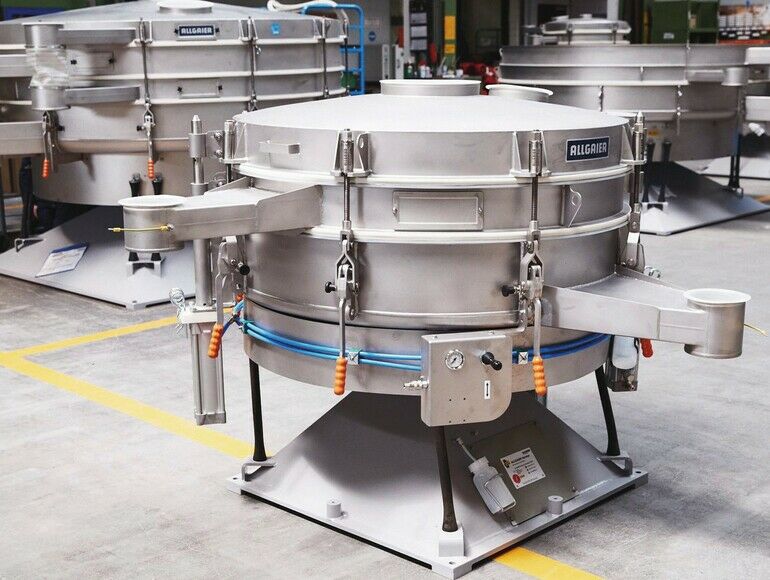There are various ways to extend the service life of screen cloths. For example, instead of standard 1.4301 (304) wire, screen cloth can be made from spring-hard 1.4310 AISI 301) steel wire or also from duplex 1.4462 (AISI 318 LN) steel, both of which have higher material hardnesses than pure austenitic stainless steels. The problem is that meshes made of such harder steel grades are not available in the full variability of mesh sizes and wire thicknesses. They are therefore not in stock and have to be specially produced as required, in as large a batch as possible, otherwise high manufacturing and delivery costs are incurred, also because of the higher material price. In addition, the processability of duplex steel wire is limited for very fine mesh sizes and wire thicknesses. Consequently, the respective meshes made of wear-resistant steels are not available for all needs for screening abrasive products or can be supplied quickly and in small quantities.
Other methods of increasing wear protection, such as coatings, have not proved successful in industrial practice because of the risk of detachment of the coating material and the resulting product contamination. Plastic fabrics, on the other hand, are only used in special applications.
Gas-based process
Allgaier Process Technology. developed a method to produce corrosion-resistant screen cloths made of almost all austenitic stainless steel grades with a service life increased by a factor of 2 to 3. The meshes are treated by a special gas-based process for which, depending on the application, the reactive atmosphere in the process of treatment is varied in terms of pressure, temperature control, gas composition and concentration, and treatment duration. This leads to an increase in the wear resistance of the wires of the screen cloth. Due to the application of gases in the process, there is a complete influence on the entire wire surfaces of the already woven screen fabric, even the surfaces touching at the crossing points of the wires. The intensity of the treatment by means of the above-mentioned process parameters is carried out as a function of the wire thickness of the fabrics, so that the ductility of the individual wires does not suffer due to possible material embrittlement and the fabrics can continue to withstand the heavy loads in vibrating screening machines. There is no negative influence on the dimensions of the meshes or wire thicknesses, and thus no negative effect on the accuracy of the meshes and the screening quality that can be achieved as a result. The corrosion resistance of the stainless steel mesh is not negatively affected by the methods used. The treatment is not comparable to coating the surfaces of the wires or meshes, which would always be associated with risks of spalling.
The method makes it possible to treat wire cloth of any mesh size and wire thickness, such as is available on the market from austenitic stainless steels in great variety, quickly and inexpensively, and to make it available as wear-resistant cloth. Woven fabrics of wear-resistant quality can be produced or supplied from wire thicknesses of around 80 µm.
Laboratory and pilot plant trials
Intensive laboratory and pilot plant trials were carried out for the development and testing of the new screens. These were carried out both with Mogensen MSizer vibratory screening machines in a continuous mode of operation with screening in the material circuit and on Allgaier tumbler screening machines TSM and TSI as well as vibratory rotary screening machines of the VRS type. Model conditions were selected for the tests on the machines in the Allgaier pilot plant. As an exemplary highly abrasive test material, freshly crushed glass granules were produced in a grain fraction suitable for the respective fabric tested, but in a grain size larger than the respective mesh size, so that batch tests without continuous material circulation were possible. The material discharge of the test machines was closed, and the product was moved on the respective screen deck during the entire test period, but not screened. Rather, only its abrasive effect on the screen cloths was investigated.
The test setup was chosen so that untreated fabrics and the new wear-resistant fabrics were subjected to exactly the same conditions. During the tests, the wear conditions were evaluated and compared at regular intervals. For this purpose, the machines were stopped after 63 hours in each case, the screen frames were removed and carefully cleaned and freed from any plugged grain. This made it possible to accurately weigh the screen frames and thus determine the mass reduction of the fabric due to wear over time. After each measurement and before continuing the test, fresh, sharp-edged glass granules were placed on each sieve.
A microscope camera was used to document the wear conditions. The figure shows an example of how the wear patterns of the untreated mesh (top) and the treated mesh (bottom) differ in the respective time intervals until the untreated mesh breaks after 399 hours. The treated fabric shows only minimal signs of wear at the time of the screen break of the untreated fabric.
The test was also continued with the new type of wear-resistant fabric still intact until it broke, while the fabric continued to be photographed and weighed at equal time intervals. The wear-resistant fabric shows the rupture after 1134 hours, i.e. another 735 hours, which corresponds to a factor on the service life of 2.84. The comparatively small abrasions at the upper bends of the warp and weft threads of the fabric can be seen, which lead to fabric breakage after a correspondingly long time.
The decrease in mass for both fabrics tested in parallel (untreated and treated) in % of the original weight over the operating time in hours was also examined. While the untreated fabric shows a rapid mass loss down to 14.4 % of the original weight, the wear of the treated fabric proceeds much more slowly and only gradually gains speed until, after a mass loss of 5.4 %, it breaks only after 1134 hours. The lower mass loss to fracture compared to the mass loss of the treated fabric shows that the treated fabric is generally still intact significantly longer than the untreated fabric. However, the test was stopped at the first small defect detected. The high mass loss of the untreated fabric until breakage illustrates a generally higher risk of breakage over the entire screen area.
Field trials in practical industrial applications
In order to validate the results of the laboratory and pilot plant trials, initial field trials were carried out at interested customers’ plants during normal production operation. Applications with particularly abrasive materials were selected, e.g. abrasives, quartz sand, blast furnace slag, volcanic sand. The new wear-resistant fabrics were tested both on Allgaier tumbler screening machines and on an MSizer from Mogensen, as well as on a flat screening machine from a third-party manufacturer. The following mesh sizes were tested: 6.3 mm; 4.5 mm; 2.5 mm; 2.0 mm; 1.5 mm; 0.71 mm; 0.63 mm
Even though not all the results of the field tests are yet available, since many of the mentioned meshes are still intact and running, it can nevertheless already be concluded that the results from the laboratory and pilot plant tests have been impressively confirmed by the field tests and that the tendencies of a clear service life extension are clearly recognisable.
Allgaier Process Technology GmbH, Uhingen
Webinar: Wear resistant screen cloth – with longer service life
Allgaier offers completely new types of wear-resistant screen cloths, which have an impressive service life that is several times longer than that of previous standard cloths. Discover the new wear-resistant screen cloths in the free webinar on Wednesday, March 29, 2023 – 10:00 am (CET). Referent: Dr.-Ing. Mathias Trojosky, Head of Research and Development.









